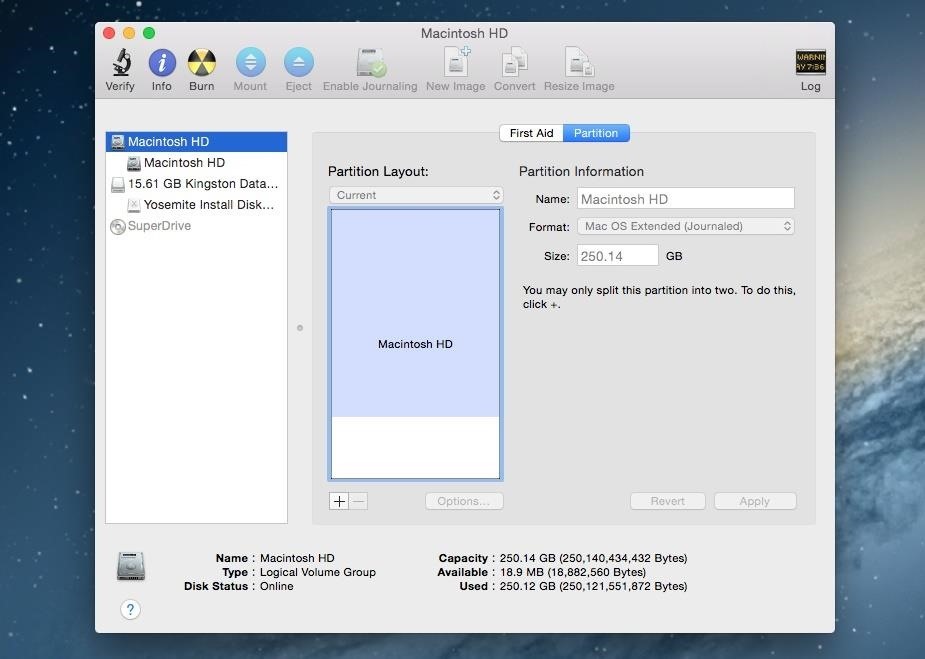
- This Version Of Os X 10.11 Cannot Be Installed On This Computer
- Os X El Capitan
- This Version Of Os X 10.11 Cannot Be Installed
- Os X Download
- This Version Of 10.11 Cannot Be Installed
- Os X Mojave
The OS X El Capitan v10.11.2 update improves the stability, compatibility, and security of your Mac, and is recommended for all users. This update: Improves the reliability of Handoff and AirDrop. Fixes an issue that may cause Bluetooth devices to disconnect. Fixes an issue that prevented Mail from deleting messages in an offline Exchange account.
This Version Of Os X 10.11 Cannot Be Installed On This Computer
Download diskmaker x. Download 10.11 but once the download is done quit out of the installer and run diskmaker x. Boot from the flash drive this will create and do an install from there. As always, back up your data first. Choosing Office for Mac compatible with OS X El Capitan (OS X 10.11) I have an old iMac which is not compatible with OS X later than El Capitan (10.11) and am considering subscribing to Office 365 Personal. However, on Microsoft's page dedicated to Office 365 Personal, it clearly states that you need at least High Sierra (10.13) to run it. Don't try to install and see the 'temporary unavailable' bug and then try the Help/Safari trick. It will not work. Reboot and redo the process with Safari first then the Install. I am unsure, but you might need to wipe the whole disk to not have any partitions available (that means Recovery HD and Macinstosh HD, using the default names). This entry was posted in Troubleshooting and tagged 10.11, El Capitan, OS X, OS X 10.11 on October 1, 2015 by Topher Kessler. Post navigation ← Reasons to both install and avoid OS X 10.11 El Capitan Fix package managers not working after installing El Capitan →.
On this page:
- Reinstalling Yosemite on a computer alreadyrunning it
Upgrading from previous versions to OS X 10.10 (Yosemite)
Os X El Capitan
OS X 10.10 (Yosemite) is no longer available for purchase from theMac App Store. If you have a previous version of the operating system,and your computer meets the system requirementsfor OS X 10.11 (El Capitan), you can upgrade directly to thatversion instead; see ARCHIVED: Install or upgrade OS X 10.11 (El Capitan)
Reinstalling Yosemite on a computer already running it
Reinstalling while keeping files, applications, and settings
- Restart your computer, and immediately hold down
command-runtil the gray Apple logo appears. - If prompted, select your main language and then click the arrow.
- Click Reinstall OS X, and then Continue. Follow the instructions on the screen, and then choose your hard disk. Click Install, and enter your Apple ID information if prompted.
- When the installation is complete, select App Store.. from the Apple menu, and install any available updates.
Reinstalling while erasing everything on your computer
Restart your computer, and immediately hold down
command-runtil the gray Apple logo appears.- If you see a screen asking you to select your main language,choose it, and then click the arrow.
- Click Disk Utility, and then Continue.
- In Disk Utility:
- Click your hard disk in the left column, and thenclick the Erase tab.
- Next to 'Format:', make sure Mac OS Extended (Journaled)is selected. In the 'Name:' field, give your disk a name.
- If you would like to securely erase your data, click SecurityOptions.., adjust the slider accordingly, and clickOK.
- When you're ready, click Erase.., and thenErase again to erase your disk.
- Once it's completed, quit Disk Utility.
- Click Reinstall OS X, and then Continue:
- Follow the instructions on the screen, and then choose your harddisk.
- Click Install. If prompted, enter your Apple IDinformation.
- Once the installation is complete, you'll beasked to enter basic information, and have the option to transfer datafrom another computer or backup.
- From the Apple menu, select App Store, and then installany available updates.
This Version Of Os X 10.11 Cannot Be Installed

Torrent client windows 7 64 bit download. On this page:
- Reinstall El Capitan on a computer alreadyrunning it
Upgrade from previous versions to OS X 10.11 (El Capitan)
- From the Apple menu, select App Store...
- When the App Store opens, search for and download El Capitan. If you don't already have an Apple ID, you'll need to create one. You can monitor the download process in the 'Purchased' section of the App Store.
- Once the download is complete, the installer should automatically open.
If it doesn't, or you don't want to complete the installation at this time, you can come back later and double-click Install OS X El Capitan in your
Applicationsfolder.Within the installer, click Continue, agree to the license agreement, and then choose the disk where you want to install El Capitan.
Tt esports black gaming mouse v2. After you begin the installation, your computer may need to restart more than once before finishing, and then you may be asked to enter basic information.
- From the Apple menu, select App Store.., and then install any available updates.
Reinstall El Capitan on a computer already running it
Os X Download
Reinstall while keeping files, applications, and settings
This Version Of 10.11 Cannot Be Installed
- Restart your computer, and immediately hold down
command-runtil the gray Apple logo appears. - If prompted, select your main language and then click the arrow.
- Click Reinstall OS X, and then Continue. Follow the instructions on the screen, and then choose your hard disk. Click Install, and enter your Apple ID information if prompted.
- When the installation is complete, select App Store.. from the Apple menu, and install any available updates.
Os X Mojave
Reinstall while erasing everything on your computer
Restart your computer, and immediately hold down
command-runtil the gray Apple logo appears.- If you see a screen asking you to select your main language, choose it, and then click the arrow.
- Click Disk Utility, and then Continue.
- In Disk Utility:
- Click your hard disk in the left column, and then click the Erase tab.
- Next to 'Format:', make sure OS X Extended (Journaled) is selected. In the 'Name:' field, give your disk a name. Click Erase.
- Once it's completed, quit Disk Utility.
- Click Reinstall OS X, and then Continue:
- Follow the instructions on the screen, and then choose your hard disk.
- Click Install. If prompted, enter your Apple ID information.
- Once the installation is complete, you'll be asked to enter basic information, and have the option to transfer data from another computer or backup.
- From the Apple menu, select App Store, and then install any available updates.